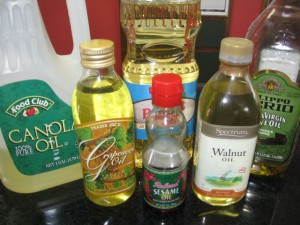There are so many cooking oils to choose from. In my kitchen, I have olive, canola, peanut, grape seed, walnut and sesame seed oil just to name a few. When do I choose one over the other? That depends on the food I’m preparing, cooking temperatures and if I want the oil to add flavor or be neutral. When I do a stir-fry, for example, food is cooked quickly over very high heat. Peanut is my oil of choice. Why? First of all, the flavor of peanut oil complements most Asian dishes. Second, peanut oil has a high smoke point. What’s that? It’s the point at which the oil begins to smoke and breakdown. If you cook with oil that’s heated past its smoke point, it will impart a burnt flavor to your food. Plus heating your oil too far beyond its smoke point could possibly start a fire. Peanut oil has a smoke point of 450 degrees F. Grape seed oil is a good alternative for stir-frying with a smoke point of 420 degrees F.
When I prepare Mediterranean dishes I often cook with olive oil or extra virgin olive oil. Temperatures are often medium to medium/high. Olive oil has a smoke point of 375-400 degrees F. Corn oil is a great all-purpose oil and my go-to when preparing Latin dishes. Its flavor is a perfect complement to Tex-Mex foods. It also has a high smoke point. Canola oil has a neutral flavor with a smoke point of 400-450 degrees F. It’s great for sauteing or baking. Sesame seed oil is all about imparting flavor. Its wonderful in marinades and has a strong smokey flavor. So use sparingly. I like to drizzle a little bit on Asian foods at the end of cooking.
Okay I’ve talked about cooking oils based on cooking temperatures, flavors and smoke points. What about nutritional information and health benefits? A few years ago, there was much discussion of saturated fats, trans fats, polyunsaturated fats and monounsaturated fats. The verdict? Saturated and trans fats are not good for you and are known as “bad” fats. Poly and monounsaturated fats are the “good” ones. All of the oils I listed above have 120 calories per 1 tablespoon serving. They vary primarily in the amounts of good fats. Canola oil has 9 grams of monounsaturated fat and 4 grams of polyunsaturated while grapeseed oil has 2 grams of monounsaturated fat and 10 grams of polyunsaturated. Peanut oil has relatively equal amounts of mono and polyunsaturated fats. Now before you run to your kitchen cupboard and start comparing oils, remember that most dishes use very little oil, sometimes 1 or 2 tablespoons in an entire pot or large skillet. If your meal yields 10 servings, that’s just a wee bit of oil per person.
Cook for fun and cook for health. Let me know what’s on your menu and I’d be happy to share it with everyone.

